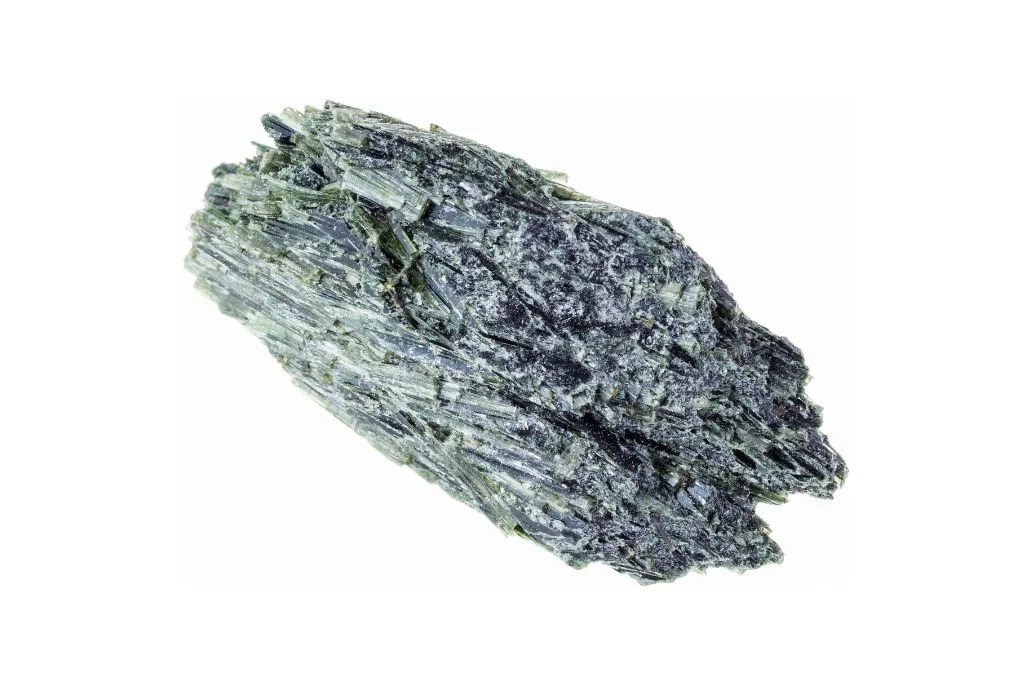Color and Appearance of Actinolite
Actinolite is a striking mineral that captivates with its distinctive appearance. This crystal typically exhibits a range of green hues, from pale and subtle to deep and rich forest greens. The color variation is largely due to its iron content, with higher iron levels producing darker shades. Some specimens may also display grayish-green or brownish-green tones, adding to the mineral’s visual diversity.
Crystal Structure and Form
One of the most notable characteristics of actinolite is its needle-like crystal structure. These slender, elongated crystals often form in radiating or fibrous masses, creating a striking visual effect. The crystals can range from fine, hair-like structures to more robust, blade-like formations. This unique growth pattern contributes to actinolite’s name, which is derived from the Greek words “aktis” (ray) and “lithos” (stone), referring to its radial habit.
Physical Properties and Unique Features
Actinolite possesses several distinctive physical properties that set it apart from other minerals. It has a vitreous to silky luster, which can give the crystal a shimmering appearance when light reflects off its surface. The mineral’s hardness ranges from 5 to 6 on the Mohs scale, making it relatively durable. Actinolite also exhibits perfect cleavage in two directions, which can result in interesting geometric patterns when the crystal is fractured or cut.
Notable Varieties and Associations
A particularly fascinating variety of actinolite is nephrite jade, a compact, interlocking form of the mineral that is highly prized for its toughness and use in carvings. Actinolite is also known to occur in association with other minerals, sometimes forming interesting composite specimens. For instance, it can be found intergrown with quartz, creating captivating green inclusions within clear crystals. These unique associations and varieties further contribute to actinolite’s appeal among mineral collectors and enthusiasts.
Physical Properties of Actinolite
Actinolite is a metamorphic mineral belonging to the amphibole group. It typically appears in shades of green, ranging from light to dark, and forms in long, slender crystals or fibrous masses. This mineral is often found in metamorphic rocks, particularly those that have undergone moderate pressure and temperature changes.
Historical and Cultural Significance
While not as widely known as some other gemstones, actinolite has been used in various cultures throughout history. In ancient times, it was sometimes used in jewelry and ornamental objects. Some Native American tribes incorporated actinolite into their spiritual practices, believing it possessed protective qualities.
Metaphysical Associations
In the realm of crystal healing and metaphysics, actinolite is associated with several beneficial properties. It is believed to promote physical vitality and emotional balance. Many practitioners claim that actinolite can help stimulate the heart chakra, fostering feelings of love, compassion, and inner peace. Some also attribute grounding and stabilizing energies to this mineral, suggesting it can help one feel more connected to the earth.
Common Uses and Applications
Today, actinolite finds applications in both practical and spiritual contexts. In industry, it is sometimes used as a source of asbestos, though this use has decreased due to health concerns. In the realm of alternative medicine and crystal therapy, actinolite is often used in meditation practices or placed on the body during healing sessions. Some people carry small pieces of actinolite as a talisman for protection and vitality. In jewelry making, high-quality specimens of actinolite may be cut into cabochons or beads, prized for their unique green color and sometimes chatoyant effect.
Believed Benefits
Proponents of crystal healing attribute various benefits to actinolite. It is said to aid in physical healing, particularly for issues related to the muscular and skeletal systems. Some believe it can help alleviate stress and anxiety, promoting a sense of calm and well-being. Actinolite is also thought to enhance one’s connection with nature, making it popular among those who practice earth-based spiritualities. While these benefits are not scientifically proven, many individuals find comfort and inspiration in working with this intriguing green mineral.

